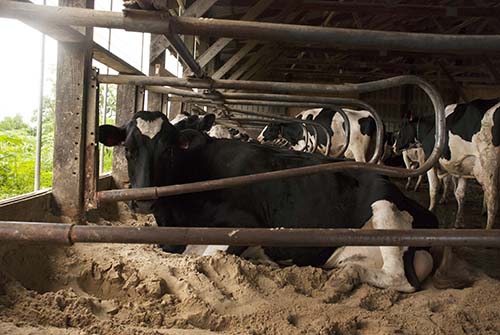
Lameness is a health and welfare issue for the entire dairy industry. In North America, an estimated 21 to 25 percent of cows housed in freestall barns are lame. Lameness can be identified through locomotion or gait scoring, but unfortunately, many farms underestimate the incidence of this disease in the herd. Earlier research found that farm employees were unable to recognize approximately 70 percent of cows that were lame. Identifying lameness in its early stages is difficult but instrumental in improving treatment success rates.
Today, technology may be a way to help farms detect lame cows sooner. Research done by Janet Higginson Cutler at the University of Guelph and others looked at changes in activity and lying behavior between cows with sound feet compared to lame cows using accelerometers. These results were shared last week at the American Dairy Science Association's Joint Annual Meeting in Indianapolis, Ind.
All 120 cows on a research dairy farm in Guelph, Ontario, Canada, were fitted with Afikim Pedometer Plus accelerometers. An earlier study by Higginson validated the accuracy of the accelerometers for use in dairy cattle. Linear mixed models were built for this study to measure if lying time differed between sound and lame cows. To determine if changes in activity were apparent in individual cows that became lame, data from the nonlame and lame periods were reviewed.
Accelerometers were read twice a day, when animals left the parlor, and hooves were examined every 3 to 4 months, with trimming performed if needed. During the study, 11 cows with ulcers, one with digital dermatitis and three with both ulcers and digital dermatitis were identified as lame. Their accelerometer output was compared to the output of 11 control cows that had sound feet.
Sound cows were more active, with 32.8 more movements per hour than lame cows. Variability in movement was also higher in sound cows. Lame cows spent more time lying down at 11.4 hours per day, compared to 9.8 hours per day for sound cows.
For cows that became lame during the study, activity and the number of lying bouts did not differ, but they did lie down for 55 more minutes per day when a painful lesion was present.
Overall, the study found that activity declined by 24 percent and lying duration tended to be longer for lame cows. The best use of accelerometer technology to detect lameness on farms would be to recognize changes in individual cow behavior from a time when they were of sound foot to the onset of lameness. The early detection of lameness would allow for more timely treatment and could reduce the prevalence of lameness in the herd.

The author is an associate editor and covers animal health, dairy housing and equipment, and nutrient management. She grew up on a dairy farm near Plymouth, Wis., and previously served as a University of Wisconsin agricultural extension agent. She received a master's degree from North Carolina State University and a bachelor's from University of Wisconsin-Madison.








